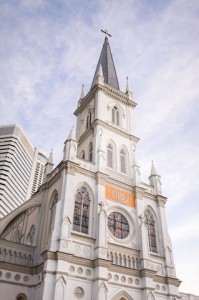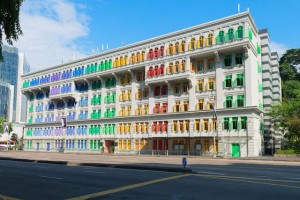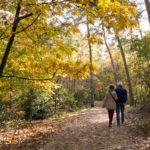This National Day, we commemorate our nation’s independence and explore 6 historical monuments in Singapore.
1. Old Ford Factory
351 Bukit Timah Road, Singapore 588192
Constructed by Ford Motor Works in 1941, this building was Ford’s first vehicle assembly plant in Southeast Asia. Yet, it has a more infamous reputation for its use as a ‘butai’ or Japanese facility to assemble military trucks and other vehicles during the Japanese Occupation. It was also the place where the British formally surrendered to the Japanese on 15 February 1942, known as Total Defence Day today.
This historic site is now gazetted as a national monument and is an exhibition gallery which holds archival records for World War II, reflecting the hardships and resilience of those who endured the darkest days of the Japanese Occupation.
2. Command House
17 Kheam Hock Road, Singapore 298791
Perched on a small hill and formerly known as Flagstaff House, this building was the official residence to dignitaries, including the most senior military commander of Malaya after World War 1, Speaker of Parliament Dr. Yeoh Khim Seng and President Ong Teng Cheong. Command House underwent extensive renovations between 1996 to 1998 and is prominent for its butterfly architecture and beautiful grounds. It is now the campus of UBS Business University and has been gazetted as a national monument in 2009.
The building is open to the public once a year, during the annual Singapore Heritage Fest.
3. CHIJMES
30 Victoria Street, Singapore 187996

CHIJMES complex was gazetted as a national monument on 26 October 1990. The three main buildings within CHIJMES complex are Caldwell House, the chapel (CHIJMES hall) and the orphanage building. Caldwell House was the first building of the complex and was residence to the nuns after their arrival in Singapore. The orphanage was home to abandoned children and is located behind Caldwell House and the chapel.
CHIJMES hall is the showpiece of the CHIJMES complex and is one of the grandest religious buildings in Singapore. The chapel underwent restoration work after its last religious service in November 1983. Today, with its beautiful infrastructure of stained glass windows that were produced in Belgium and high arched ceilings, the Gothic-style chapel is a popular venue for weddings.
4. Maghain Aboth Synagogue
24/26 Waterloo Street, Singapore 187968
“Maghain Aboth” means “Shield of our Fathers” in Hebrew. Located in the former Jewish neighbourhood, this synagogue was the first Jewish quarter in Singapore and is one of the oldest surviving Jewish buildings in Southeast Asia. It was an important meeting place for the Jews to exchange news and collect funds during the Japanese Occupation. Oil lamps which were used during services in the past still hang from steel rods today and in memory of those who have passed on.
The synagogue has retained an elegant simplicity with its neo-classical and colonial architecture. The covered porch protrudes from the front of the building and has a wide flight of steps leading up to the main entrance of the building. The hall inside features traditional Roman columns and walls that are clean of decorations or images. The U-shaped balcony on the second storey is reserved for female members during prayer service.
The synagogue is still used as the main place of worship for the Jewish community today and was gazetted as a national monument on 27 February 1998. It is open all year round. Service is held daily, except on Mondays.
5. House of Tan Yeok Nee
101 Penang Road, Singapore 238466
Constructed in the traditional southern Chinese style in 1882, this mansion is the last remaining building of the Four Mansions built by rich Teochew tycoons in the late 19th century in Singapore. It was the residence of Tan Yeok Nee, a wealthy Teochew businessman and was acquired by Singapore’s first railway company later on. The house suffered from significant damage when the Japanese army occupied it during World War II and much money was spent by the Salvation Army on its restoration. After being bought over by a few more hands, the house was restored between 1999 and 2000 and is now site to the University of Chicago, Graduate School of Business and gazetted a national monument since 19 November 1974.
The house stands as a tribute to the contributions of early Chinese immigrants. It has a large doorway with high walls, colourful roofs decorated with porcelain and expansive interiors, characterised by wood carvings, calligraphy and paintings. Much of the original architecture has been kept intact, with the inclusion of some European features such as French windows.
6. Ministry of Information, Communication & The Arts (MICA)
140 Hill Street, Singapore 179369

The Old Hill Street Police Station was gazetted a national monument on 18 December 1998 and is now headquarters for the Ministry of Information and the Arts. Built in neo-classical style common of public buildings in England in the 1930s, it is now a six-storey building with two internal courtyards and art galleries on the ground floor.










